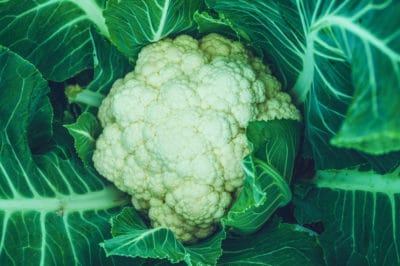Disease
Plant diseases live and thrive in depleted and dead soil. Healthy soil has a microbial ecosystem in which all forms of life are carefully balanced and it’s unlikely that one fungus or bacteria will become prevalent enough to infect crops. Properly made compost can give a boost to unbalanced soil, improve it’s living biota, and prevent disease from spreading. Areas with high commercial production tend to carry far more soil problems.
Some common diseases that affect cauliflower include:
- Black Leaf Spot
- Soft Rot
- Damping Off
Black Leaf Spot
Also called Alternaria Leaf Spot, this fungal pathogen affects brassicas like cauliflower, tomatoes, and potatoes. It appears as 1/2 inch circular spots on the leaves that range in color from black to tan. They can also appear as concentric rings as the disease progresses. It may take a while, but plants will die from Alternaria.
Cleaning up plant material in the fall is important, spores will spread from decaying plant matter onto your seeds. Mulching young plants early in the season will slow the disease down and reduce the number of plants affected. Organic growers can purchase a number of copper-based sprays for heavily infected plants.
Soft Rot
Erwinia cartovorum is a bacteria well known for infecting potato crops, but it can also spread throughout the garden onto many plants including cauliflower. It begins as small black spots and quickly ends in a blackened stinky mess. Soft rot bacteria are found all over the world in virtually every climate, once it infects your plant there is no cure. The plant must be destroyed.
Because it’s everywhere in nature, all you can do is learn how to manage and prevent soft rot from infecting plants. It thrives in wet conditions, so make sure your garden soil is well draining. Clean garden tools between uses to avoid spreading it. Corn, peas, and beets have a natural resistance to soft rot. Rotate them into an area to keep populations down.
Damping Off
One day it looks like your seedling stem melted in the middle and the young plant has fallen over. Depending on the particular strain of fungi it may manifest as stunting, wilting, or yellowing. This group of soil fungi typically affect young seedlings, but can also cause damage to older plants.
Dampening off is as it sounds, a problem of too much moisture. The bacteria thrive in wet and warm conditions. Avoid keeping seedlings overly wet in greenhouses or starting trays. Ensure that your potting mixes do not become water-logged. Organic fungicides may prevent it from spreading.
